对美国货币政策框架的权威介绍
美国的发展及其货币政策。
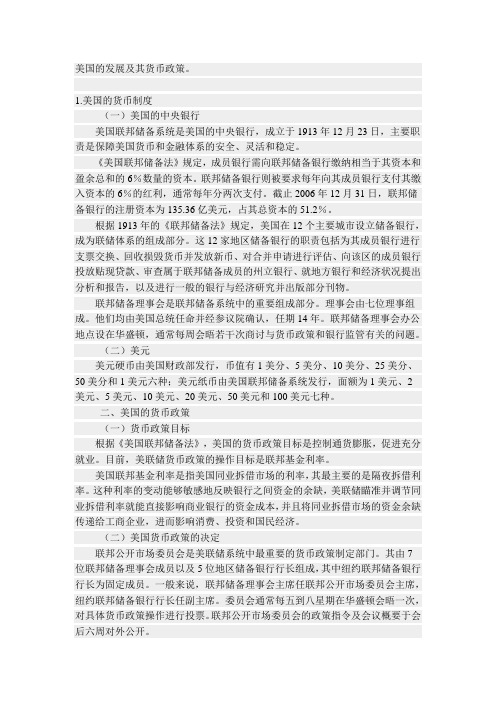
美国的发展及其货币政策。
1.美国的货币制度(一)美国的中央银行美国联邦储备系统是美国的中央银行,成立于1913年12月23日,主要职责是保障美国货币和金融体系的安全、灵活和稳定。
《美国联邦储备法》规定,成员银行需向联邦储备银行缴纳相当于其资本和盈余总和的6%数量的资本。
联邦储备银行则被要求每年向其成员银行支付其缴入资本的6%的红利,通常每年分两次支付。
截止2006年12月31日,联邦储备银行的注册资本为135.36亿美元,占其总资本的51.2%。
根据1913年的《联邦储备法》规定,美国在12个主要城市设立储备银行,成为联储体系的组成部分。
这12家地区储备银行的职责包括为其成员银行进行支票交换、回收损毁货币并发放新币、对合并申请进行评估、向该区的成员银行投放贴现贷款、审查属于联邦储备成员的州立银行、就地方银行和经济状况提出分析和报告,以及进行一般的银行与经济研究并出版部分刊物。
联邦储备理事会是联邦储备系统中的重要组成部分。
理事会由七位理事组成。
他们均由美国总统任命并经参议院确认,任期14年。
联邦储备理事会办公地点设在华盛顿,通常每周会晤若干次商讨与货币政策和银行监管有关的问题。
(二)美元美元硬币由美国财政部发行,币值有1美分、5美分、10美分、25美分、50美分和1美元六种;美元纸币由美国联邦储备系统发行,面额为1美元、2美元、5美元、10美元、20美元、50美元和100美元七种。
二、美国的货币政策(一)货币政策目标根据《美国联邦储备法》,美国的货币政策目标是控制通货膨胀,促进充分就业。
目前,美联储货币政策的操作目标是联邦基金利率。
美国联邦基金利率是指美国同业拆借市场的利率,其最主要的是隔夜拆借利率。
这种利率的变动能够敏感地反映银行之间资金的余缺,美联储瞄准并调节同业拆借利率就能直接影响商业银行的资金成本,并且将同业拆借市场的资金余缺传递给工商企业,进而影响消费、投资和国民经济。
(二)美国货币政策的决定联邦公开市场委员会是美联储系统中最重要的货币政策制定部门。
美国的货币政策全解

美联储选择银行信用作为货币政策的中间目标,为了刺激企业投资和个 人消费,在这个时期进一步推进低利率的廉价货币政策,使得信用急剧膨胀。
政策效果: 1974年到1975年和80年代初的两次经济危机期间,在 生产下降和失业率猛增的同时,物价不但没有下跌反而 普遍大幅度上涨。
新经济时期
时间: 90年代初到现在
战后初期的政策
第一轮量化宽松政策
滞涨时期的政策
第二轮量化宽松政策
新经济时期的政策
战后初期
背景: 在30年代后半期全球性经济大萧条时期,出现了凯恩 斯主义,它主张用扩张性的宏观经济政策来刺激经济,使 经济摆脱衰退状态。这一政策措施在当时存在大量失业资 源的情况下,起到了一定的作用。二战结束后,由于美国 为维护其霸主地位,军事开支有增无减,导致财政赤字上 升,这样,只能用增发货币的方式来缓和;加之战时的物 价管制放开,致使通货膨胀率上升很快。
政策效果: 1、美国的通货膨胀率时高时低,交替进行。总的趋 势:通货膨胀率较高的年份带来了经济的衰退而低通 货膨胀率则是经济增长速度回升。
原因:货币政策的时滞性。
滞涨时期
背景: 在经历了50年代中期到60年代中期的低通货膨胀率之后,从60年代后 半期开始,美国的通货膨胀率不断上升,进入70年代后出现了新的情况。 时间: 70年代初期到80年代初期 政策:
政策效果: 到1998年,美国经济的持续增长已进入了第8个年头,
第一轮量化宽松政策
背景:雷曼兄弟公司于2008年9月倒闭 措施:在2008年11月25日,美联储购买了1.725亿美 元资产,主要是通过将储备贷给它们的附属机构,然 后通过直接购买抵押贷款支持证券。 市场影响:从2009年3月1日至2010年3月31日,美股 标普500指数涨幅为37.14%。美国经济在2009年中期 触底反弹,当年后三个季度的国内生产总值环比增速 从负值逐步增至5%。
从泰勒规则看美联储政策框架的演变与革新
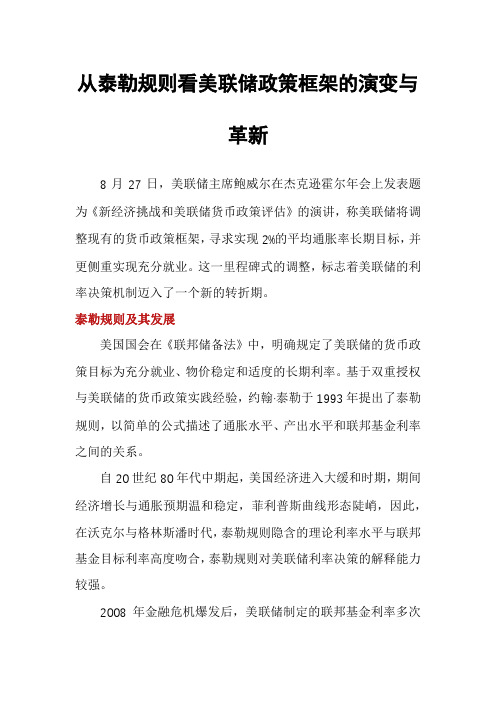
从泰勒规则看美联储政策框架的演变与革新8月27日,美联储主席鲍威尔在杰克逊霍尔年会上发表题为《新经济挑战和美联储货币政策评估》的演讲,称美联储将调整现有的货币政策框架,寻求实现2%的平均通胀率长期目标,并更侧重实现充分就业。
这一里程碑式的调整,标志着美联储的利率决策机制迈入了一个新的转折期。
泰勒规则及其发展美国国会在《联邦储备法》中,明确规定了美联储的货币政策目标为充分就业、物价稳定和适度的长期利率。
基于双重授权与美联储的货币政策实践经验,约翰·泰勒于1993年提出了泰勒规则,以简单的公式描述了通胀水平、产出水平和联邦基金利率之间的关系。
自20世纪80年代中期起,美国经济进入大缓和时期,期间经济增长与通胀预期温和稳定,菲利普斯曲线形态陡峭,因此,在沃克尔与格林斯潘时代,泰勒规则隐含的理论利率水平与联邦基金目标利率高度吻合,泰勒规则对美联储利率决策的解释能力较强。
2008年金融危机爆发后,美联储制定的联邦基金利率多次偏離传统泰勒规则隐含的理论利率目标,传统泰勒规则的适用性迎来了巨大挑战。
因此美联储官员与经济学家们,根据危机应对的特殊要求和美国经济结构变化,对泰勒规则的变量和参数进行了一系列修订。
2008年,金融危机导致美国经济陷入严重衰退,相较于价格稳定,当时美联储更为看重经济产出目标,伯南克对传统泰勒规则进行修订,将产出缺口的反应系数从0.5提升至1,潜在通胀目标由2%提升至2.5%。
2012年,美国经济开始复苏,但失业率仍然高企,美联储主张在经济深度衰退之后的复苏阶段,应相对长时间地维持超低利率。
基于伯南克的鸽派立场,伊文思规则应运而生,将货币政策与就业紧密挂钩,向市场传达美联储注重经济增长(尤其是充分就业)的政策信号,同时,引入经济指标的临界值作为加息的触发标准,承诺在失业率低于6.5%以及通胀率预期高于2.5%之前,美联储将维持零利率水平不变。
2014年耶伦继任后,对劳动力市场的重视程度进一步加强,基于此前多轮修订的泰勒规则,耶伦发展出了最优控制方法,使联邦基金目标利率能够最小化失业率和通胀率与目标值的偏离度。
美国货币政策与利率调整
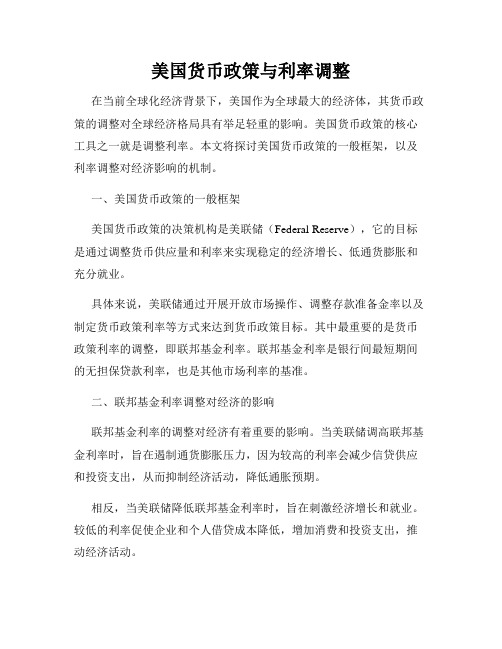
美国货币政策与利率调整在当前全球化经济背景下,美国作为全球最大的经济体,其货币政策的调整对全球经济格局具有举足轻重的影响。
美国货币政策的核心工具之一就是调整利率。
本文将探讨美国货币政策的一般框架,以及利率调整对经济影响的机制。
一、美国货币政策的一般框架美国货币政策的决策机构是美联储(Federal Reserve),它的目标是通过调整货币供应量和利率来实现稳定的经济增长、低通货膨胀和充分就业。
具体来说,美联储通过开展开放市场操作、调整存款准备金率以及制定货币政策利率等方式来达到货币政策目标。
其中最重要的是货币政策利率的调整,即联邦基金利率。
联邦基金利率是银行间最短期间的无担保贷款利率,也是其他市场利率的基准。
二、联邦基金利率调整对经济的影响联邦基金利率的调整对经济有着重要的影响。
当美联储调高联邦基金利率时,旨在遏制通货膨胀压力,因为较高的利率会减少信贷供应和投资支出,从而抑制经济活动,降低通胀预期。
相反,当美联储降低联邦基金利率时,旨在刺激经济增长和就业。
较低的利率促使企业和个人借贷成本降低,增加消费和投资支出,推动经济活动。
三、联邦基金利率调整的影响因素联邦基金利率的调整取决于一系列因素。
首先是经济数据,包括就业数据、通胀数据以及经济增长数据。
美联储会根据这些数据来判断经济状况,并据此调整利率。
其次是全球经济状况。
由于美国是全球最大的经济体,全球经济的变化也会对美国经济产生影响。
例如,全球经济增长疲软或金融市场动荡可能促使美联储调低利率来支持经济增长。
最后是货币政策的前瞻性。
美联储之前的利率调整并不仅仅取决于当前经济数据,还考虑到对未来经济预期的影响。
因此,市场对于美联储领导人的讲话和评论也会密切关注,以预测未来货币政策的走向。
四、美国货币政策的全球影响美国货币政策调整对全球经济产生广泛影响。
首先,美国是全球最大的经济体,其经济状况和货币政策变化会对其他国家和地区的经济产生溢出效应。
其次,美国货币政策的调整会导致全球金融市场的波动。
美联储货币政策目标
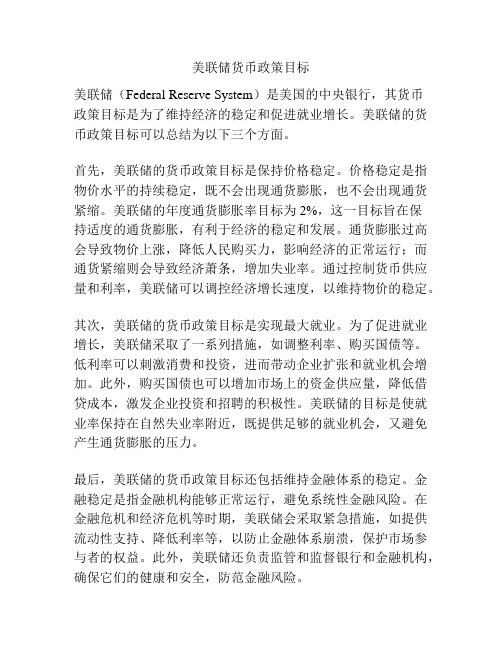
美联储货币政策目标美联储(Federal Reserve System)是美国的中央银行,其货币政策目标是为了维持经济的稳定和促进就业增长。
美联储的货币政策目标可以总结为以下三个方面。
首先,美联储的货币政策目标是保持价格稳定。
价格稳定是指物价水平的持续稳定,既不会出现通货膨胀,也不会出现通货紧缩。
美联储的年度通货膨胀率目标为2%,这一目标旨在保持适度的通货膨胀,有利于经济的稳定和发展。
通货膨胀过高会导致物价上涨,降低人民购买力,影响经济的正常运行;而通货紧缩则会导致经济萧条,增加失业率。
通过控制货币供应量和利率,美联储可以调控经济增长速度,以维持物价的稳定。
其次,美联储的货币政策目标是实现最大就业。
为了促进就业增长,美联储采取了一系列措施,如调整利率、购买国债等。
低利率可以刺激消费和投资,进而带动企业扩张和就业机会增加。
此外,购买国债也可以增加市场上的资金供应量,降低借贷成本,激发企业投资和招聘的积极性。
美联储的目标是使就业率保持在自然失业率附近,既提供足够的就业机会,又避免产生通货膨胀的压力。
最后,美联储的货币政策目标还包括维持金融体系的稳定。
金融稳定是指金融机构能够正常运行,避免系统性金融风险。
在金融危机和经济危机等时期,美联储会采取紧急措施,如提供流动性支持、降低利率等,以防止金融体系崩溃,保护市场参与者的权益。
此外,美联储还负责监管和监督银行和金融机构,确保它们的健康和安全,防范金融风险。
综上所述,美联储的货币政策目标是保持价格稳定、实现最大就业和维持金融体系的稳定。
通过调整货币供应量和利率等手段,美联储可以调控经济的增长速度,防范通货膨胀和经济衰退的风险,为美国经济的稳定和健康发展提供支持。
美联储美国货币政策的决策机构
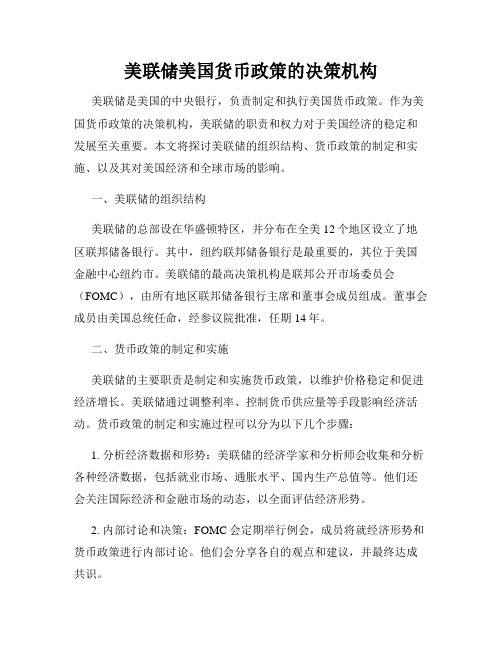
美联储美国货币政策的决策机构美联储是美国的中央银行,负责制定和执行美国货币政策。
作为美国货币政策的决策机构,美联储的职责和权力对于美国经济的稳定和发展至关重要。
本文将探讨美联储的组织结构、货币政策的制定和实施、以及其对美国经济和全球市场的影响。
一、美联储的组织结构美联储的总部设在华盛顿特区,并分布在全美12个地区设立了地区联邦储备银行。
其中,纽约联邦储备银行是最重要的,其位于美国金融中心纽约市。
美联储的最高决策机构是联邦公开市场委员会(FOMC),由所有地区联邦储备银行主席和董事会成员组成。
董事会成员由美国总统任命,经参议院批准,任期14年。
二、货币政策的制定和实施美联储的主要职责是制定和实施货币政策,以维护价格稳定和促进经济增长。
美联储通过调整利率、控制货币供应量等手段影响经济活动。
货币政策的制定和实施过程可以分为以下几个步骤:1. 分析经济数据和形势:美联储的经济学家和分析师会收集和分析各种经济数据,包括就业市场、通胀水平、国内生产总值等。
他们还会关注国际经济和金融市场的动态,以全面评估经济形势。
2. 内部讨论和决策:FOMC会定期举行例会,成员将就经济形势和货币政策进行内部讨论。
他们会分享各自的观点和建议,并最终达成共识。
3. 公共沟通:FOMC会通过新闻发布会和出版的会议纪要等渠道向公众传达货币政策的决定。
这样做的目的是提供透明度,使公众了解美联储的立场和决策依据。
4. 实施货币政策:美联储可以通过调整短期利率,如联邦基金利率,来影响市场利率和货币供应量。
此外,美联储还可以进行公开市场操作,即买卖国债和其他金融资产,以调节银行体系的储备金水平。
三、美联储对美国经济的影响美联储的货币政策对美国经济具有重要影响。
通过调整利率,美联储能够影响消费、投资和就业等经济指标。
当经济增长过热,通胀压力上升时,美联储可能会加息以抑制通胀。
相反,当经济衰退或通缩风险增加时,美联储可能会降息以刺激经济活动。
美联储的三大核心制度
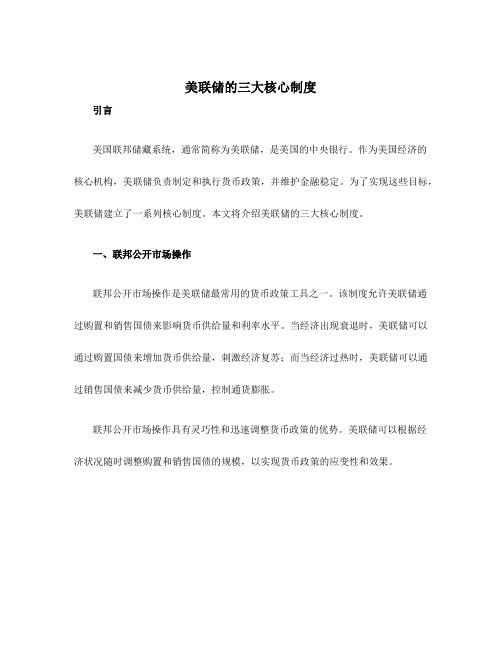
美联储的三大核心制度引言美国联邦储藏系统,通常简称为美联储,是美国的中央银行。
作为美国经济的核心机构,美联储负责制定和执行货币政策,并维护金融稳定。
为了实现这些目标,美联储建立了一系列核心制度。
本文将介绍美联储的三大核心制度。
一、联邦公开市场操作联邦公开市场操作是美联储最常用的货币政策工具之一。
该制度允许美联储通过购置和销售国债来影响货币供给量和利率水平。
当经济出现衰退时,美联储可以通过购置国债来增加货币供给量,刺激经济复苏;而当经济过热时,美联储可以通过销售国债来减少货币供给量,控制通货膨胀。
联邦公开市场操作具有灵巧性和迅速调整货币政策的优势。
美联储可以根据经济状况随时调整购置和销售国债的规模,以实现货币政策的应变性和效果。
二、贴现窗口借贷贴现窗口借贷是美联储提供给商业银行的紧急援助机制。
当商业银行无法在市场上获得足够的流动性时,可以向美联储的贴现窗口借款。
贴现窗口借贷可以帮助商业银行充分满足付款和资金流动的要求,维护金融体系的稳定。
贴现窗口借贷是美联储的最后一道防线,只在紧急情况下才使用。
由于贴现窗口借贷可能会导致市场对银行的信心下降,美联储设定了较高的利率,以鼓励商业银行在面临流动性问题时优先寻求其他支持和解决方案。
三、存款准备金制度存款准备金制度是美联储通过设立准备金要求来管理商业银行的存款储藏。
准备金要求规定商业银行必须持有一定比例的存款准备金,以应对存款的提取需求。
存款准备金制度旨在维护金融体系的稳定和可靠性。
存款准备金制度可以影响商业银行的贷款发放能力和市场流动性。
通过调整存款准备金率,美联储可以控制银行的存款储藏量,从而影响银行的贷款规模和市场流动性。
这项制度是美联储调节经济的重要工具之一。
结论美联储的三大核心制度——联邦公开市场操作、贴现窗口借贷和存款准备金制度,共同构成了美国货币政策和金融稳定的基石。
这些制度具有灵巧性、及时性和稳定性等特点,可以帮助美联储有效应对经济波动和金融危机。
美国主导的国际货币体系的演进和危机
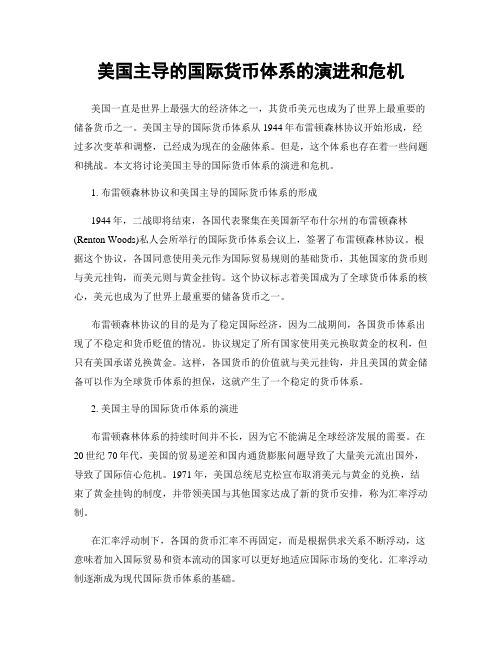
美国主导的国际货币体系的演进和危机美国一直是世界上最强大的经济体之一,其货币美元也成为了世界上最重要的储备货币之一。
美国主导的国际货币体系从1944年布雷顿森林协议开始形成,经过多次变革和调整,已经成为现在的金融体系。
但是,这个体系也存在着一些问题和挑战。
本文将讨论美国主导的国际货币体系的演进和危机。
1. 布雷顿森林协议和美国主导的国际货币体系的形成1944年,二战即将结束,各国代表聚集在美国新罕布什尔州的布雷顿森林(Renton Woods)私人会所举行的国际货币体系会议上,签署了布雷顿森林协议。
根据这个协议,各国同意使用美元作为国际贸易规则的基础货币,其他国家的货币则与美元挂钩,而美元则与黄金挂钩。
这个协议标志着美国成为了全球货币体系的核心,美元也成为了世界上最重要的储备货币之一。
布雷顿森林协议的目的是为了稳定国际经济,因为二战期间,各国货币体系出现了不稳定和货币贬值的情况。
协议规定了所有国家使用美元换取黄金的权利,但只有美国承诺兑换黄金。
这样,各国货币的价值就与美元挂钩,并且美国的黄金储备可以作为全球货币体系的担保,这就产生了一个稳定的货币体系。
2. 美国主导的国际货币体系的演进布雷顿森林体系的持续时间并不长,因为它不能满足全球经济发展的需要。
在20世纪70年代,美国的贸易逆差和国内通货膨胀问题导致了大量美元流出国外,导致了国际信心危机。
1971年,美国总统尼克松宣布取消美元与黄金的兑换,结束了黄金挂钩的制度,并带领美国与其他国家达成了新的货币安排,称为汇率浮动制。
在汇率浮动制下,各国的货币汇率不再固定,而是根据供求关系不断浮动,这意味着加入国际贸易和资本流动的国家可以更好地适应国际市场的变化。
汇率浮动制逐渐成为现代国际货币体系的基础。
到了20世纪80年代,美国把货币政策与国内的消费需求紧密结合,导致了大量的贸易逆差,同时国内通货膨胀也开始加剧。
为了纠正这种状况,美国政府采取了松散的货币政策,不断增加货币供应量,打压美元汇率。
美联储的货币政策目标
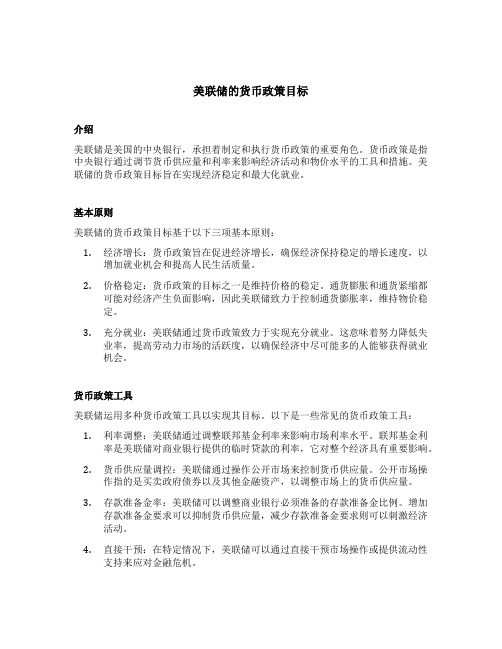
美联储的货币政策目标介绍美联储是美国的中央银行,承担着制定和执行货币政策的重要角色。
货币政策是指中央银行通过调节货币供应量和利率来影响经济活动和物价水平的工具和措施。
美联储的货币政策目标旨在实现经济稳定和最大化就业。
基本原则美联储的货币政策目标基于以下三项基本原则:1.经济增长:货币政策旨在促进经济增长,确保经济保持稳定的增长速度,以增加就业机会和提高人民生活质量。
2.价格稳定:货币政策的目标之一是维持价格的稳定。
通货膨胀和通货紧缩都可能对经济产生负面影响,因此美联储致力于控制通货膨胀率,维持物价稳定。
3.充分就业:美联储通过货币政策致力于实现充分就业。
这意味着努力降低失业率,提高劳动力市场的活跃度,以确保经济中尽可能多的人能够获得就业机会。
货币政策工具美联储运用多种货币政策工具以实现其目标。
以下是一些常见的货币政策工具:1.利率调整:美联储通过调整联邦基金利率来影响市场利率水平。
联邦基金利率是美联储对商业银行提供的临时贷款的利率,它对整个经济具有重要影响。
2.货币供应量调控:美联储通过操作公开市场来控制货币供应量。
公开市场操作指的是买卖政府债券以及其他金融资产,以调整市场上的货币供应量。
3.存款准备金率:美联储可以调整商业银行必须准备的存款准备金比例。
增加存款准备金要求可以抑制货币供应量,减少存款准备金要求则可以刺激经济活动。
4.直接干预:在特定情况下,美联储可以通过直接干预市场操作或提供流动性支持来应对金融危机。
货币政策目标的实现为了实现其货币政策目标,美联储采取了以下措施:1.定期审查和分析经济数据:美联储定期审查和分析国内外的经济数据,以了解经济状况和趋势,并根据其分析结果调整货币政策。
2.经济预测:美联储通过经济预测模型和专业分析,预测未来的经济走势,以便制定相应的货币政策。
3.透明度和沟通:美联储重视与公众的沟通,通过发布货币政策声明、定期记者会等方式向公众传递货币政策信息,以增强市场的透明度和稳定性。
美国量化宽松货币政策及其影响
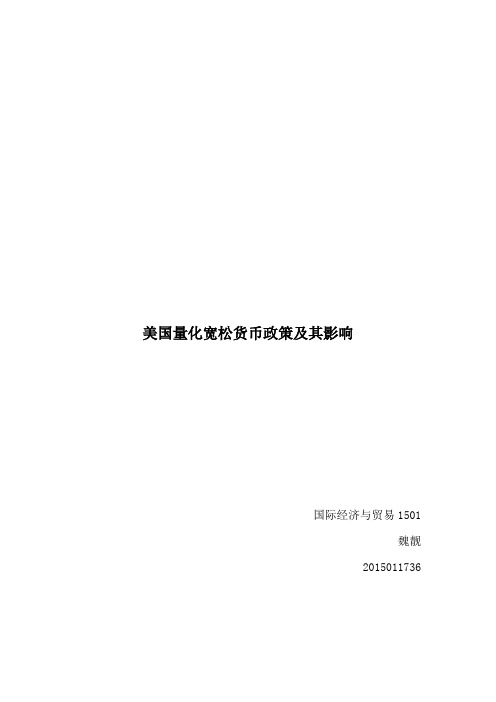
美国量化宽松货币政策及其影响国际经济与贸易1501魏靓2015011736美国量化宽松货币政策及其影响一、货币政策货币政策是指中央银行为实现既定的目标,运用各种工具调节货币供应量来调节市场利率,通过市场利率的变化来影响民间的资本投资,影响总需求来影响宏观经济运行的各种方针措施。
调节总需求的货币政策的三大工具为法定准备金率,公开市场业务和贴现政策。
二、量化宽松量化宽松主要是指中央银行在实行零利率或近似零利率政策后,通过购买国债等中长期债券,增加基础货币供给,向市场注入大量流动性资金的干预方式,以鼓励开支和借贷,也被简化地形容为间接增印钞票。
量化指的是扩大一定数量的货币发行,宽松即减少银行的资金压力。
当银行和金融机构的有价证券被央行收购时,新发行的钱币便被成功地投入到私有银行体系。
量化宽松政策所涉及的政府债券,不仅金额庞大,而且周期也较长。
一般来说,只有在利率等常规工具不再有效的情况下,货币当局才会采取这种极端做法。
三、美国量化宽松货币政策历次内容(一)QE1的内容2008年11月25日,美联储首次公布将购买机构债和MBS,标志着首轮量化宽松政策的开始。
2010年4月28日,联储的首轮量化宽松政策正式结束。
QE1将购买政府支持企业(简称GSE)房利美、房地美、联邦住房贷款银行与房地产有关的直接债务,还将购买由两房、联邦政府国民抵押贷款协会(Ginnie Mae)所担保的抵押贷款支持证券(MBS)。
2009年3月18日机构抵押贷款支持证券的采购额最高增至1.25万亿美元,机构债的采购额最高增至2000亿美元。
此外,为促进私有信贷市场状况的改善,联储还决定在未来六个月中最高再购买3000亿美元的较长期国债证券。
美联储在首轮量化宽松政策的执行期间共购买了1.725万亿美元资产。
QE1的主体上是用于购买国家担保的问题金融资产,重建金融机构信用,向信贷市场注入流动性,用意在于稳定信贷市场。
值得关注的是,美联储的目的仅仅在于“稳定”市场,而不是“刺激”经济,这与中国央行的量化宽松大相径庭。
美国的汇率制度与外汇制度

美国的汇率制度与外汇制度引言概述:汇率制度和外汇制度是国家货币政策的重要组成部分,对于一个国家的经济发展和国际贸易具有重要影响。
本文将重点探讨美国的汇率制度与外汇制度,分析其特点和对美国经济的影响。
一、美国的汇率制度1.1 固定汇率制度美国在20世纪初采用了固定汇率制度,即将美元与黄金挂钩,以固定的汇率兑换其他货币。
这种制度有助于稳定汇率,提高国际贸易的可预测性和信任度。
1.2 浮动汇率制度20世纪70年代,美国放弃了固定汇率制度,转向浮动汇率制度。
根据市场供求关系,美元与其他货币的汇率会不断波动。
这种制度使得美国货币政策更具灵活性,能够更好地应对经济变化和外部冲击。
1.3 汇率政策的调整美国政府会根据国内外经济形势和政策目标,采取适当的汇率政策调整。
例如,通过干预外汇市场或改变利率政策来影响汇率水平。
这种调整有助于维护国内经济的稳定和国际竞争力。
二、美国的外汇制度2.1 外汇市场的开放性美国外汇市场相对开放,允许外国投资者自由买卖美元和其他货币。
这种开放性有利于促进国际资金流动和跨国贸易,提高市场效率和资源配置效益。
2.2 外汇管制与监管尽管外汇市场相对自由,美国政府仍对外汇交易进行一定程度的管制和监管。
例如,美国货币当局会制定外汇政策,规范外汇市场的运作,以防止不良行为和金融风险的发生。
2.3 外汇储备的管理美国作为全球最大的经济体之一,拥有庞大的外汇储备。
美国政府通过有效管理外汇储备,维护国际收支平衡和汇率稳定。
外汇储备的管理还可以用于应对金融危机和其他国际经济风险。
三、美国汇率制度与外汇制度的影响3.1 经济增长和就业汇率制度和外汇制度的稳定与灵活性,对美国经济的增长和就业有着重要影响。
稳定的汇率有助于提高国际贸易的可预测性和信任度,促进出口和进口的增长。
灵活的外汇制度能够更好地应对国际经济环境的变化,减轻经济波动对就业的冲击。
3.2 通货膨胀和物价稳定汇率制度和外汇制度的调整对通货膨胀和物价稳定也具有重要影响。
美国货币政策分析
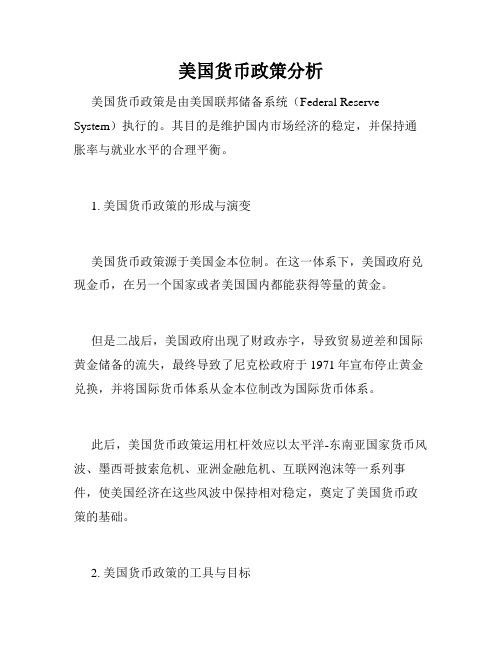
美国货币政策分析美国货币政策是由美国联邦储备系统(Federal Reserve System)执行的。
其目的是维护国内市场经济的稳定,并保持通胀率与就业水平的合理平衡。
1. 美国货币政策的形成与演变美国货币政策源于美国金本位制。
在这一体系下,美国政府兑现金币,在另一个国家或者美国国内都能获得等量的黄金。
但是二战后,美国政府出现了财政赤字,导致贸易逆差和国际黄金储备的流失,最终导致了尼克松政府于1971年宣布停止黄金兑换,并将国际货币体系从金本位制改为国际货币体系。
此后,美国货币政策运用杠杆效应以太平洋-东南亚国家货币风波、墨西哥披索危机、亚洲金融危机、互联网泡沫等一系列事件,使美国经济在这些风波中保持相对稳定,奠定了美国货币政策的基础。
2. 美国货币政策的工具与目标美国货币政策可以使用的工具很多,最常用的是利率和货币政策回购。
同时,还可以进行外汇干预和控制储蓄利率等手段。
该政策的目标是维持经济增长、低通胀率、高就业率和稳定汇率等。
其中,就业率和通胀率是美国货币政策最重要的两个目标。
3. 美国货币政策的实施美国货币政策的执行是由联邦公开市场业务(Federal Open Market Committee)和12个联邦储备行组成的。
其中,联邦公开市场委员会负责制定货币政策。
而12个联邦储备行则负责实现货币政策并监督银行体系。
联邦公开市场委员会执行货币政策有三种方式:一是直接向银行委托购买或出售美国政府债券;二是调整银行的存款准备金率;三是透过调整直接向银行借贷的利率来影响货币市场。
4. 美国货币政策的优缺点美国货币政策的优点在于它可以快速响应经济周期的变化,并且可以改变政策,以保持经济的稳定。
但是,美国货币政策也存在缺点。
一是对于其他国家可能会产生相对负面的影响;二是在实现稳定汇率和高就业率目标时,通常会牺牲掉其他目标,例如稳定价格;三是美国货币政策执行过程中可能会导致其他国家经济波动变化,特别是那些美元依赖国家的经济。
美联储货币政策目标

美联储货币政策目标美联储(theFederalReserve)是美国主要金融监管机构,由联邦政府和12 个地区联邦储备银行组成,主要负责金融体系的监管和管理工作。
此外,美联储还负责定价的政策,也就是货币政策。
货币政策的目标是促进经济的稳定和可持续发展,通过减少或增加货币供给来调节通货膨胀和经济的波动。
美联储的货币政策的主要目标是就业、物价稳定和经济增长。
美联储在实施货币政策时,会考虑到多个因素,其中最重要的是促进就业率的增加。
美国就业率一直在增长,这是一种普遍趋势。
此外,美联储还致力于稳定价格,也就是控制通货膨胀。
通货膨胀不仅影响美国国内消费者,还会影响它的国际竞争力。
美国的通货膨胀目标一直处于2%左右,与历史数据相比,这一数字是相当稳定的。
另一个重要的目标是增加经济的增长。
美联储在过去的几十年中已经有很多货币政策来促进经济的增长,比如采用低利率策略,或者发行新的货币来支撑经济增长。
然而,这种策略也会抑制通货膨胀,所以美联储需要在这两个方面较量,以得到最佳的货币政策。
美联储在实施货币政策的过程中,需要密切关注经济增长指标、通货膨胀和就业指标等,以便根据实际情况调整货币政策,以达到上述目标。
美联储也会使用某些金融工具来实施货币政策,例如货币市场操纵工具(MMT)、央行利率定价(IPR)等。
这些金融工具可以帮助美联储实现其货币政策目标,同时避免出现不利的经济后果。
经过几十年的实践和试验,美联储已经制定出非常有效和成熟的货币政策,其目的在于实现就业、物价稳定和经济增长。
美联储可以根据实际情况调整货币政策,以满足当前经济状况的需求,同时保护金融系统的稳定。
未来,美联储将继续实施货币政策,以助力美国经济的可持续发展。
美国货币管理制度
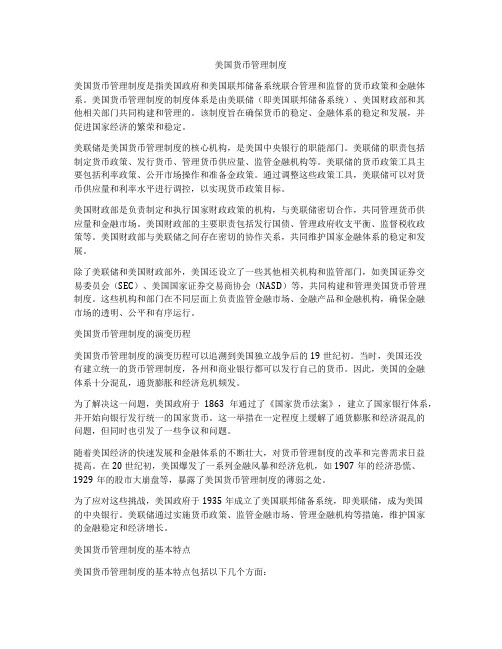
美国货币管理制度美国货币管理制度是指美国政府和美国联邦储备系统联合管理和监督的货币政策和金融体系。
美国货币管理制度的制度体系是由美联储(即美国联邦储备系统)、美国财政部和其他相关部门共同构建和管理的。
该制度旨在确保货币的稳定、金融体系的稳定和发展,并促进国家经济的繁荣和稳定。
美联储是美国货币管理制度的核心机构,是美国中央银行的职能部门。
美联储的职责包括制定货币政策、发行货币、管理货币供应量、监管金融机构等。
美联储的货币政策工具主要包括利率政策、公开市场操作和准备金政策。
通过调整这些政策工具,美联储可以对货币供应量和利率水平进行调控,以实现货币政策目标。
美国财政部是负责制定和执行国家财政政策的机构,与美联储密切合作,共同管理货币供应量和金融市场。
美国财政部的主要职责包括发行国债、管理政府收支平衡、监督税收政策等。
美国财政部与美联储之间存在密切的协作关系,共同维护国家金融体系的稳定和发展。
除了美联储和美国财政部外,美国还设立了一些其他相关机构和监管部门,如美国证券交易委员会(SEC)、美国国家证券交易商协会(NASD)等,共同构建和管理美国货币管理制度。
这些机构和部门在不同层面上负责监管金融市场、金融产品和金融机构,确保金融市场的透明、公平和有序运行。
美国货币管理制度的演变历程美国货币管理制度的演变历程可以追溯到美国独立战争后的19世纪初。
当时,美国还没有建立统一的货币管理制度,各州和商业银行都可以发行自己的货币。
因此,美国的金融体系十分混乱,通货膨胀和经济危机频发。
为了解决这一问题,美国政府于1863年通过了《国家货币法案》,建立了国家银行体系,并开始向银行发行统一的国家货币。
这一举措在一定程度上缓解了通货膨胀和经济混乱的问题,但同时也引发了一些争议和问题。
随着美国经济的快速发展和金融体系的不断壮大,对货币管理制度的改革和完善需求日益提高。
在20世纪初,美国爆发了一系列金融风暴和经济危机,如1907年的经济恐慌、1929年的股市大崩盘等,暴露了美国货币管理制度的薄弱之处。
美国货币政策传导机制

美国货币政策传导机制一、美国货币政策的传导机制按照传统经济学中的描述,中央银行货币政策的传导机制主要是:通过央行控制基础货币,进而控制货币供给来影响利率。
当存在某种程度的价格粘性的情况下,名义利率的变动会影响实际利率,实际利率的变动进一步影响资本使用者的成本。
这种影响将会导致投资和消费支出的变化,从而最终导致总产出的变化。
这个货币政策传导过程在凯恩斯主义经济学的is-lm模型中得到了充分的表述。
就货币政策的传导机制而言,存在着很多个货币政策的传导渠道。
以美国为例,其货币政策的传导渠道可以细分为:狭义信贷渠道、广义信贷渠道、财富渠道、利率渠道、汇率渠道等。
狭义信贷(或称之为银行贷款)渠道,是指:由于银行主要依赖储备性的活期存款作为贷款的资金来源,通过减少银行储备的总量,紧缩性的货币政策就可以降低银行发放贷款的能力。
由于大量的企业和居民主要依靠或只能依靠银行来筹集资金,银行贷款供给的减少必然会使总支出收缩。
广义信贷渠道,在美国,该渠道主要表现为抵押贷款(mortgage loan)。
根据利率与资产价格的关系,当利率上升时,资产价格会下降;反之,当利率下降时,资产价格则会上升。
在货币政策传导的广义信贷渠道中,资产的价格变得尤其重要,原因在于它决定了公司和消费者用于获得抵押贷款的抵押品的价值。
虽然抵押品价值的下降并不必然代表借款者偿债能力的下降,但在信息不对称以及存在代理人成本的情况下,抵押品价值的下降将导致借款者外部融资成本的增加。
这样,货币政策的效应通过广义信贷渠道得到了放大。
财富渠道,是建立在莫迪利亚尼(modigliani)和安东(ando)于提出的生命周期消费模型的基础之上的。
根据这个理论,消费者是根据一生当中如何最优地分配消费的意图,来计划他们的长期消费和储蓄行为的。
消费者的收入来源有两个渠道,一个是劳动收入,另一个是财产性收入(包括股票、债券和房地产等方面的投资收入)。
当货币政策变动导致利率发生变化时,消费者拥有的资产的价值也会发生变化。
美联储的货币政策目标
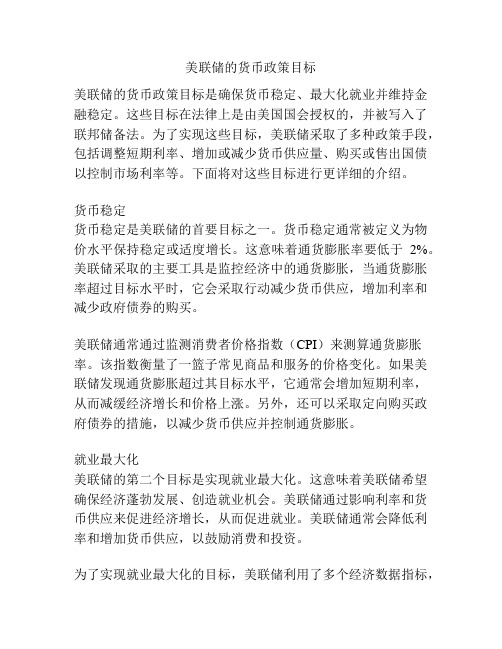
美联储的货币政策目标美联储的货币政策目标是确保货币稳定、最大化就业并维持金融稳定。
这些目标在法律上是由美国国会授权的,并被写入了联邦储备法。
为了实现这些目标,美联储采取了多种政策手段,包括调整短期利率、增加或减少货币供应量、购买或售出国债以控制市场利率等。
下面将对这些目标进行更详细的介绍。
货币稳定货币稳定是美联储的首要目标之一。
货币稳定通常被定义为物价水平保持稳定或适度增长。
这意味着通货膨胀率要低于2%。
美联储采取的主要工具是监控经济中的通货膨胀,当通货膨胀率超过目标水平时,它会采取行动减少货币供应,增加利率和减少政府债券的购买。
美联储通常通过监测消费者价格指数(CPI)来测算通货膨胀率。
该指数衡量了一篮子常见商品和服务的价格变化。
如果美联储发现通货膨胀超过其目标水平,它通常会增加短期利率,从而减缓经济增长和价格上涨。
另外,还可以采取定向购买政府债券的措施,以减少货币供应并控制通货膨胀。
就业最大化美联储的第二个目标是实现就业最大化。
这意味着美联储希望确保经济蓬勃发展、创造就业机会。
美联储通过影响利率和货币供应来促进经济增长,从而促进就业。
美联储通常会降低利率和增加货币供应,以鼓励消费和投资。
为了实现就业最大化的目标,美联储利用了多个经济数据指标,如劳动参与率、非农就业人数和失业率等,来评估就业市场的情况。
如果不足,它将采取措施,例如降低利率和增加货币供应,从而刺激经济增长和就业增长。
金融稳定第三个目标是维护金融稳定。
金融稳定包括保护美国金融系统的稳定和强大,以及确保银行和其他金融机构能够继续为经济提供支持。
美联储管理着金融机构,并创建了相应的规定来确保其表现良好。
为了实现金融稳定,美联储对金融机构的监管非常重要。
它实施各种规则和监管来确保金融机构在拥有较大财务自由度的同时,保持稳定。
它监控银行的负债和资产,并确保它们拥有足够的资金来偿还债务。
最重要的是,它确保金融系统能够维持流动性,以确保长期稳健的增长。
1913年以来美联储政策目标、框架及责任演变
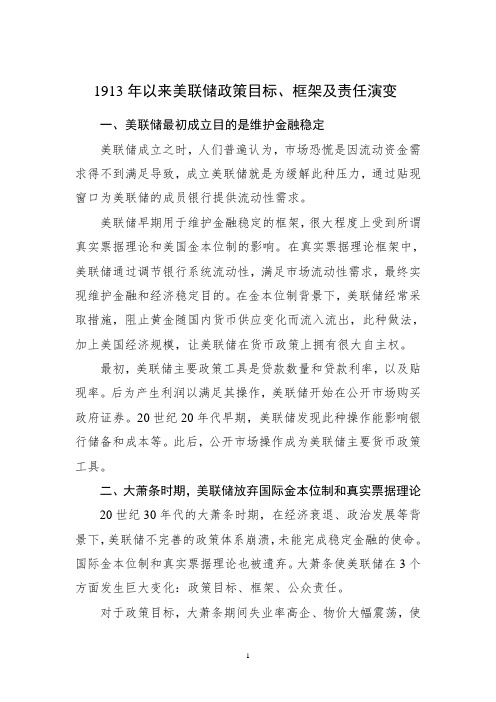
1913年以来美联储政策目标、框架及责任演变一、美联储最初成立目的是维护金融稳定美联储成立之时,人们普遍认为,市场恐慌是因流动资金需求得不到满足导致,成立美联储就是为缓解此种压力,通过贴现窗口为美联储的成员银行提供流动性需求。
美联储早期用于维护金融稳定的框架,很大程度上受到所谓真实票据理论和美国金本位制的影响。
在真实票据理论框架中,美联储通过调节银行系统流动性,满足市场流动性需求,最终实现维护金融和经济稳定目的。
在金本位制背景下,美联储经常采取措施,阻止黄金随国内货币供应变化而流入流出,此种做法,加上美国经济规模,让美联储在货币政策上拥有很大自主权。
最初,美联储主要政策工具是贷款数量和贷款利率,以及贴现率。
后为产生利润以满足其操作,美联储开始在公开市场购买政府证券。
20世纪20年代早期,美联储发现此种操作能影响银行储备和成本等。
此后,公开市场操作成为美联储主要货币政策工具。
二、大萧条时期,美联储放弃国际金本位制和真实票据理论20世纪30年代的大萧条时期,在经济衰退、政治发展等背景下,美联储不完善的政策体系崩溃,未能完成稳定金融的使命。
国际金本位制和真实票据理论也被遗弃。
大萧条使美联储在3个方面发生巨大变化:政策目标、框架、公众责任。
对于政策目标,大萧条期间失业率高企、物价大幅震荡,使得美联储增加了提高或维护充分就业、稳定物价的使命。
对于政策框架,开始关注货币政策对实际经济活动和就业的影响,以及帮助减少周期性波动。
同时,不再注重于维护金融稳定,部分原因是20世纪30年代成立了联邦存款保险公司和证券交易委员会,以及其他改革促使金融体系变得更稳定。
在治理和对公众责任上,1935年的银行法,从法律上加强了美联储独立性,为其提供了更强集中控制力。
尤其该法案创造了现代美国联邦公开市场委员会(FOMC)设置,董事会大多数委员拥有表决权。
但实践中,财政部继续对货币政策有很大影响,直到1951年美联储才开始恢复真正独立。
美联储货币政策的有效性评估
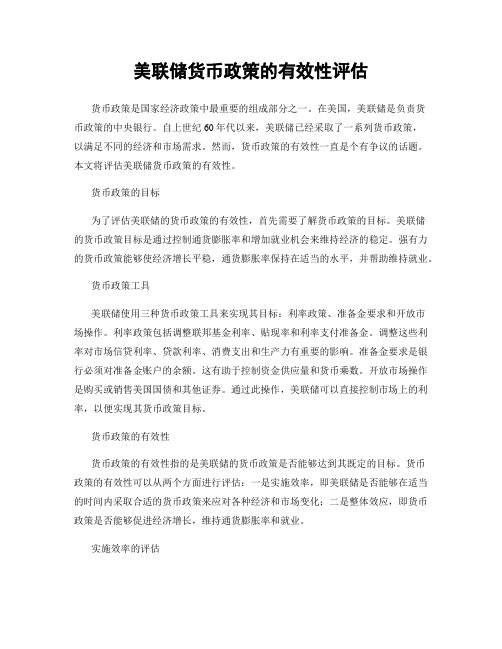
美联储货币政策的有效性评估货币政策是国家经济政策中最重要的组成部分之一。
在美国,美联储是负责货币政策的中央银行。
自上世纪60年代以来,美联储已经采取了一系列货币政策,以满足不同的经济和市场需求。
然而,货币政策的有效性一直是个有争议的话题。
本文将评估美联储货币政策的有效性。
货币政策的目标为了评估美联储的货币政策的有效性,首先需要了解货币政策的目标。
美联储的货币政策目标是通过控制通货膨胀率和增加就业机会来维持经济的稳定。
强有力的货币政策能够使经济增长平稳,通货膨胀率保持在适当的水平,并帮助维持就业。
货币政策工具美联储使用三种货币政策工具来实现其目标:利率政策、准备金要求和开放市场操作。
利率政策包括调整联邦基金利率、贴现率和利率支付准备金。
调整这些利率对市场信贷利率、贷款利率、消费支出和生产力有重要的影响。
准备金要求是银行必须对准备金账户的余额。
这有助于控制资金供应量和货币乘数。
开放市场操作是购买或销售美国国债和其他证券。
通过此操作,美联储可以直接控制市场上的利率,以便实现其货币政策目标。
货币政策的有效性货币政策的有效性指的是美联储的货币政策是否能够达到其既定的目标。
货币政策的有效性可以从两个方面进行评估:一是实施效率,即美联储是否能够在适当的时间内采取合适的货币政策来应对各种经济和市场变化;二是整体效应,即货币政策是否能够促进经济增长,维持通货膨胀率和就业。
实施效率的评估实施效率意味着美联储能否在适当的时间内采取行动以影响经济和市场变化。
实施效率的主要障碍包括货币政策的传导机制的失灵和信息缺失。
传导机制失灵意味着利率、汇率和信贷市场未因美联储货币政策的变化而做出相应的反应。
信息缺失意味着美联储缺乏必要的信息来做出货币政策决策。
然而,美联储的宏观经济数据和金融市场监测能力已经得到了显著的提高,这有助于缓解信息缺失的问题。
此外,政策制定者可以采取国际协调措施,以避免通货膨胀资本的流出,这也有利于提高货币政策的实施效率。
美联储的货币政策目标

美联储的货币政策目标一、前言美联储是美国的中央银行,其主要职责是制定并执行货币政策,维护金融稳定和经济增长。
货币政策目标是美联储制定货币政策的核心,本文将详细介绍美联储的货币政策目标。
二、宏观经济目标美联储的货币政策目标与宏观经济目标密切相关。
美联储通过调整货币政策来实现以下宏观经济目标:1.稳定通货膨胀率通货膨胀率是指物价水平上涨的速度。
稳定通货膨胀率是保持价格稳定和经济增长的关键。
在这方面,美联储设立了一个通货膨胀率目标,并通过调整利率来实现这一目标。
2.最大化就业机会就业机会是衡量经济繁荣程度的重要指标之一。
为了实现最大化就业机会,美联储采取了一系列措施,如降低利率等。
3.促进经济增长促进经济增长是保持经济繁荣和提高人民生活水平的关键。
美联储通过货币政策来促进经济增长,如降低利率等。
三、货币政策目标美联储的货币政策目标主要包括以下几个方面:1.维持价格稳定美联储的主要任务是维持价格稳定。
为了实现这一目标,美联储设立了一个通货膨胀率目标,即2%左右。
如果通货膨胀率超过或低于这个目标,美联储将采取相应的措施来调整货币供应量和利率水平。
2.促进最大就业为了促进最大就业,美联储采取了一系列措施来降低失业率。
其中之一是通过调整利率来影响信贷市场和企业投资决策。
如果失业率过高,美联储将降低利率以刺激投资和消费,并促进经济增长和就业机会。
3.维护金融稳定金融稳定是保持经济繁荣和社会稳定的关键。
为了维护金融稳定,美联储采取了一系列措施来监管银行和其他金融机构,并确保它们的运作不会对整个金融系统产生负面影响。
4.促进经济增长为了促进经济增长,美联储采取了一系列措施来刺激投资和消费。
其中之一是通过降低利率来鼓励企业投资和消费。
美联储还通过购买国债等方式来增加货币供应量,以促进经济增长。
四、货币政策工具为了实现货币政策目标,美联储使用以下几种货币政策工具:1.调整利率利率是影响信贷市场和企业投资决策的重要因素之一。
- 1、下载文档前请自行甄别文档内容的完整性,平台不提供额外的编辑、内容补充、找答案等附加服务。
- 2、"仅部分预览"的文档,不可在线预览部分如存在完整性等问题,可反馈申请退款(可完整预览的文档不适用该条件!)。
- 3、如文档侵犯您的权益,请联系客服反馈,我们会尽快为您处理(人工客服工作时间:9:00-18:30)。
U.S. Monetary Policy: An IntroductionThis site provides an introduction to U.S. monetary policy as it is currently conducted by answering a series of questions:U.S. monetary policy affects all kinds of economic and financial decisions people make in this country—whether to get a loan to buy a new house or car or to start up a company, whether to expand a business by investing in a new plant or equipment, and whether to put savings in a bank, in bonds, or in the stock market, for example. Furthermore, because the U.S. is the largest economy in the world, its monetary policy also has significant economic and financial effects on other countries.The object of monetary policy is to influence the performance of the economy as reflected in such factors as inflation, economic output, and employment. It works by affecting demand across the economy—that is, people's and firms' willingness to spend on goods and services.While most people are familiar with the fiscal policy tools that affect demand—such as taxes and government spending—many are less familiar with monetary policy and its tools. Monetary policy is conducted by the Federal Reserve System, the nation's central bank, and it influences demand mainly by raising and lowering short-term interest rates.1. How is the Federal Reserve structured?The Federal Reserve System (called the Fed, for short) is the nation's central bank. It was established by an Act of Congress in 1913 and consists of the seven members of the Board of Governors in Washington, D.C., and twelve Federal Reserve District Banks (see the map; for a discussion of the Fed's overall responsibilities, see The Federal Reserve System: Purposes and Functions).The Congress structured the Fed to be independent within the government—that is, although the Fed is accountable to the Congress, it is insulated from day-to-day political pressures. This reflects the conviction that the people who control the country's money supply should be independent of the people who frame the government's spending decisions. Most studies of central bank independence rank the Fed among the most independent in the world.2. What makes the Fed independent?Three structural features make the Fed independent: the appointment procedure for governors, the appointment procedure for Reserve Bank Presidents, and funding.Appointment Procedure for GovernorsThe seven Governors on the Federal Reserve Board are appointed by the President of the United States and confirmed by the Senate. Independence derives from a couple of factors: first, the appointments are staggered to reduce the chance that a single U.S. President could "load" the Board with appointees; second their terms of office are 14 years—much longer than elected officials' terms.Appointment Procedure for Reserve Bank PresidentsEach Reserve Bank President is appointed to a five-year term by that Bank's Board of Directors, subject to final approval by the Board of Governors. This procedure adds to independence because the Directors of each Reserve Bank are not chosen by politicians but are selected to provide a cross-section of interests within the region, including those of depository institutions, nonfinancial businesses, labor, and the public.FundingThe Fed is structured to be self-sufficient in the sense that it meets its operating expenses primarily from the interest earnings on its portfolio of securities. Therefore, it is independent of Congressional decisions about appropriations.3. How is the Fed "independent within the government"?Even though the Fed is independent of Congressional appropriations and administrative control, it is ultimately accountable to Congress and comes under government audit and review. The Chairman, other Governors, and Reserve Bank Presidents report regularly to the Congress on monetary policy, regulatory policy, and a variety of other issues, and meet with senior Administration officials to discuss the Federal Reserve's and the federal government's economic programs. The Fed also reports to Congress regarding its finances.4. Who makes monetary policy?The Fed's FOMC (Federal Open Market Committee) has primary responsibility for conducting monetary policy. The FOMC meets in Washington eight times a year and has twelve members: the seven members of the Board of Governors, the President of the Federal Reserve Bank of New York, and four of the other Reserve Bank Presidents, who serve in rotation. The remaining Reserve Bank Presidents contribute to the Committee's discussions and deliberations.In addition, the Directors of each Reserve Bank contribute to monetary policy by making recommendations about the appropriate discount rate, which are subject to final approval by the Governors.What are the tools of monetary policy?The Fed can't control inflation or influence output and employment directly; instead, it affects them indirectly, mainly by raising or loweringshort-term interest rates. The Fed affects interest rates mainly through open market operations and the discount rate, and both of these methods work through the market for bank reserves, known as the federal funds market.5. What are bank reserves?Banks and other depository institutions (for convenience, we'll refer to all of these as "banks") are legally required to hold a specific amount of funds in reserve. These funds, which can be used to meet unexpected outflows, are called reserves, and banks keep them as cash in their vaults or as deposits with the Fed. Currently, banks must hold between 3% and 10% of the funds they have in interest-bearing and non-interest-bearing checking accounts as reserves (depending on the dollar amount of such accounts held at each bank). Banks also may hold additional reserves needed for clearing overnight checks and other payments.6. What is the federal funds market?From day to day, the amount of reserves a bank has to hold may change as its deposits and transactions change. When a bank needs additional reserves on a short-term basis, it can borrow them from other banks that happen to have more reserves than they need. These loans take place in a private financial market called the federal funds market.The interest rate on the overnight borrowing of reserves is called the federal funds rate or simply the "funds rate." It adjusts to balance the supply of and demand for reserves. For example, an increase in the amount of reservessupplied to the federal funds market causes the funds rate to fall, while a decrease in the supply of reserves raises that rate.7. What are open market operations?The major tool the Fed uses to affect the supply of reserves in the banking system is open market operations—that is, the Fed buys and sells government securities on the open market. These operations are conducted by the Federal Reserve Bank of New York.Suppose the Fed wants the funds rate to fall. To do this, it buys government securities from a bank. The Fed then pays for the securities by increasing that bank's reserves. As a result, the bank now has more reserves than it is required to hold. So the bank can lend these excess reserves to another bank in the federal funds market. Thus, the Fed's open market purchase increases the supply of reserves to the banking system, and the federal funds rate falls.When the Fed wants the funds rate to rise, it does the reverse, that is, it sells government securities. The Fed receives payment in reserves from banks, which lowers the supply of reserves in the banking system, and the funds rate rises.8. What is the discount rate?Banks also can borrow reserves from the Federal Reserve Banks at their "discount windows," and the interest rate they must pay on this borrowing is called the discount rate. The total quantity of discount window borrowing tends to be small, because the Fed discourages such borrowing except to meet occasional short-term reserve deficiencies (see The Federal Reserve: Purposes and Functions for a discussion of other types of discount window borrowing that are unrelated to monetary policy).The discount rate plays a role in monetary policy because, traditionally, changes in the rate may have "announcement effects"—that is, they sometimes signal to markets a significant change in monetary policy. A higher discount rate can be used to indicate a more restrictive policy, while a lower rate may signal a more expansionary policy. Therefore, discount rate changes are often coordinated with FOMC decisions to change the funds rate.9. What about foreign currency operations?Purchases and sales of foreign currency by the Fed are directed by the FOMC, acting in cooperation with the Treasury, which has overall responsibility for these operations. The Fed does not have targets, or desired levels, for the exchange rate. Instead, the Fed gets involved to counter disorderly movements in foreign exchange markets, such as speculative movements that may disrupt the efficient functioning of these markets or of financial markets in general. For example, during some periods of disorderly declines in the dollar, the Fed has purchased dollars (sold foreign currency) to absorb some of the selling pressure.Intervention operations involving dollars, whether initiated by the Fed, the Treasury, or by a foreign authority, are not allowed to alter the supply of bank reserves or the funds rate. The process of keeping intervention from affecting reserves and the funds rate is called the "sterilization" of exchange market operations. As such, these operations are not used as a tool of monetary policy.10. How does monetary policy affect the economy?The point of implementing policy through raising or lowering interest rates is to affect people's and firms' demand for goods and services. Thissection discusses how policy actions affect real interest rates, which in turn affect demand and ultimately output, employment, and inflation.11. What are real interest rates and why do they matter?For the most part, the demand for goods and services is not related to the market interest rates quoted on the financial pages of newspapers, known as nominal rates. Instead, it is related to real interest rates—that is, nominal interest rates minus the expected rate of inflation.Variations in expected inflation can make a big difference in interpreting the stance of monetary policy. In 1978, the nominal funds rate averaged 8%, but the rate of inflation was 9%. So, even though nominal interest rates were high, monetary policy actually was stimulating demand with a negative real funds rate of minus 1%.By contrast, in early 1999, the nominal funds rate was 4-3/4% and the inflation rate was running at about 2%. This implied a positive 2-3/4% real funds rate. So the nominal funds rate of 8% in 1978 was more stimulative than the 4-3/4% nominal funds rate in early 1999.12. How do real interest rates affect economic activity in the short run?Changes in real interest rates affect the public's demand for goods and services mainly by altering borrowing costs, the availability of bank loans, the wealth of households, and foreign exchange rates.For example, a decrease in real interest rates lowers the cost of borrowing and leads to increases in business investment spending and household purchases of durable goods, such as autos and new homes.In addition, lower real rates and a healthy economy may increase banks' willingness to lend to businesses and households. This may increase spending, especially by smaller borrowers who have few sources of credit other than banks.Lower real rates make common stocks and other such investments more attractive than bonds and other debt instruments; as a result, common stock prices tend to rise. Households with stocks in their portfolios find that the value of their holdings has gone up, and this increase in wealth makes them willing to spend more. Higher stock prices also make it more attractive for businesses to invest in plant and equipment by issuing stock.In the short run, lower real interest rates in the U.S. also tend to reduce the foreign exchange value of the dollar, which lowers the prices of the exports we sell abroad and raises the prices we pay for foreign-produced goods. This leads to higher aggregate spending on goods and services produced in the U.S.The increase in aggregate demand for the economy's output through these various channels leads firms to raise production and employment, which in turn increases business spending on capital goods even further by making greater demands on existing factory capacity. It also boosts consumption further because of the income gains that result from the higher level of economic output.13. How does monetary policy affect inflation?Wages and prices will begin to rise at faster rates if monetary policy stimulates aggregate demand enough to push labor and capital markets beyond their long-run capacities. In fact, a monetary policy that persistently attempts to keep short-term real rates low will lead eventually to higher inflation and higher nominal interest rates, with no permanent increases in thegrowth of output or decreases in unemployment. As noted earlier, in the long run, output and employment cannot be set by monetary policy. In other words, while there is a trade-off between higher inflation and lower unemployment in the short run, the trade-off disappears in the long run.Policy also can affect inflation directly through people's expectations about future inflation. For example, suppose the Fed eases monetary policy. If consumers and businesspeople expect higher inflation in the future, they'll ask for bigger increases in wages and prices. That in itself will raise inflation without big changes in employment and output.14. Doesn't U.S. inflation depend on worldwide capacity, not just U.S. capacity?In this era of intense global competition, it might seem parochial to focus on U.S. capacity as a determinant of U.S. inflation, rather than on world capacity. For example, some argue that even if unemployment in the U.S. drops to very low levels, U.S. workers wouldn't be able to push for higher wages, because they're competing for jobs with workers abroad, who are willing to accept much lower wages.This reasoning doesn't hold up too well, however, for a couple of reasons. First, a large proportion of what we consume in the U.S. isn't affected very much by foreign trade. One example is health care, which isn't traded internationally and which amounts to about 14% of GDP.Second, even when we consider goods that are traded internationally, the effect on U.S. prices is largely offset by flexible foreign exchange rates. Suppose the price of steel, or some other good, is lower in Japan than in the U.S. When U.S. manufacturers buy Japanese steel, they have to pay for it in yen, which they buy on the foreign exchange market. As a result, the value of the yen will climb relative to the dollar, and the cost of Japanese steel to U.S.firms will go up—even though the Japanese have not changed the (yen) price they charge.15. How long does it take a policy action to affect the economy and inflation?The lags in monetary policy are long and variable. The major effects of a change in policy on growth in the overall production of goods and services usually are felt within three months to two years. And the effects on inflation tend to involve even longer lags, perhaps one to three years, or more.16. Why are the lags so hard to predict?Since monetary policy is aimed at affecting people's demand, it's dealing with human responses, which are changeable and hard to predict.For example, the effect of a policy action on the economy will depend on what people think the Fed action means for inflation in the future. If people believe that a tightening of policy means the Fed is determined to keep inflation under control, they'll immediately expect low inflation in the future, so they're likely to ask for smaller wage and price increases, and this will help to achieve that end. But if people aren't convinced that the Fed is going to contain inflation, they're likely to ask for bigger wage and price increases, and that means that inflation is likely to rise. In this case, the only way to bring inflation down is to tighten so much and for so long that there are significant losses in employment and output.How does monetary policy affect the economy?The point of implementing policy through raising or lowering interest rates is to affect people's and firms' demand for goods and services. Thissection discusses how policy actions affect real interest rates, which in turn affect demand and ultimately output, employment, and inflation.17. What are real interest rates and why do they matter?For the most part, the demand for goods and services is not related to the market interest rates quoted on the financial pages of newspapers, known as nominal rates. Instead, it is related to real interest rates—that is, nominal interest rates minus the expected rate of inflation.Variations in expected inflation can make a big difference in interpreting the stance of monetary policy. In 1978, the nominal funds rate averaged 8%, but the rate of inflation was 9%. So, even though nominal interest rates were high, monetary policy actually was stimulating demand with a negative real funds rate of minus 1%.By contrast, in early 1999, the nominal funds rate was 4-3/4% and the inflation rate was running at about 2%. This implied a positive 2-3/4% real funds rate. So the nominal funds rate of 8% in 1978 was more stimulative than the 4-3/4% nominal funds rate in early 1999.18. How do real interest rates affect economic activity in the short run?Changes in real interest rates affect the public's demand for goods and services mainly by altering borrowing costs, the availability of bank loans, the wealth of households, and foreign exchange rates.For example, a decrease in real interest rates lowers the cost of borrowing and leads to increases in business investment spending and household purchases of durable goods, such as autos and new homes.In addition, lower real rates and a healthy economy may increase banks' willingness to lend to businesses and households. This may increase spending, especially by smaller borrowers who have few sources of credit other than banks.Lower real rates make common stocks and other such investments more attractive than bonds and other debt instruments; as a result, common stock prices tend to rise. Households with stocks in their portfolios find that the value of their holdings has gone up, and this increase in wealth makes them willing to spend more. Higher stock prices also make it more attractive for businesses to invest in plant and equipment by issuing stock.In the short run, lower real interest rates in the U.S. also tend to reduce the foreign exchange value of the dollar, which lowers the prices of the exports we sell abroad and raises the prices we pay for foreign-produced goods. This leads to higher aggregate spending on goods and services produced in the U.S.The increase in aggregate demand for the economy's output through these various channels leads firms to raise production and employment, which in turn increases business spending on capital goods even further by making greater demands on existing factory capacity. It also boosts consumption further because of the income gains that result from the higher level of economic output.19. How does monetary policy affect inflation?Wages and prices will begin to rise at faster rates if monetary policy stimulates aggregate demand enough to push labor and capital markets beyond their long-run capacities. In fact, a monetary policy that persistently attempts to keep short-term real rates low will lead eventually to higher inflation and higher nominal interest rates, with no permanent increases in thegrowth of output or decreases in unemployment. As noted earlier, in the long run, output and employment cannot be set by monetary policy. In other words, while there is a trade-off between higher inflation and lower unemployment in the short run, the trade-off disappears in the long run.Policy also can affect inflation directly through people's expectations about future inflation. For example, suppose the Fed eases monetary policy. If consumers and businesspeople expect higher inflation in the future, they'll ask for bigger increases in wages and prices. That in itself will raise inflation without big changes in employment and output.20. Doesn't U.S. inflation depend on worldwide capacity, not just U.S. capacity?In this era of intense global competition, it might seem parochial to focus on U.S. capacity as a determinant of U.S. inflation, rather than on world capacity. For example, some argue that even if unemployment in the U.S. drops to very low levels, U.S. workers wouldn't be able to push for higher wages, because they're competing for jobs with workers abroad, who are willing to accept much lower wages.This reasoning doesn't hold up too well, however, for a couple of reasons. First, a large proportion of what we consume in the U.S. isn't affected very much by foreign trade. One example is health care, which isn't traded internationally and which amounts to about 14% of GDP.Second, even when we consider goods that are traded internationally, the effect on U.S. prices is largely offset by flexible foreign exchange rates. Suppose the price of steel, or some other good, is lower in Japan than in the U.S. When U.S. manufacturers buy Japanese steel, they have to pay for it in yen, which they buy on the foreign exchange market. As a result, the value of the yen will climb relative to the dollar, and the cost of Japanese steel to U.S.firms will go up—even though the Japanese have not changed the (yen) price they charge.21. How long does it take a policy action to affect the economy and inflation?The lags in monetary policy are long and variable. The major effects of a change in policy on growth in the overall production of goods and services usually are felt within three months to two years. And the effects on inflation tend to involve even longer lags, perhaps one to three years, or more.22. Why are the lags so hard to predict?Since monetary policy is aimed at affecting people's demand, it's dealing with human responses, which are changeable and hard to predict.For example, the effect of a policy action on the economy will depend on what people think the Fed action means for inflation in the future. If people believe that a tightening of policy means the Fed is determined to keep inflation under control, they'll immediately expect low inflation in the future, so they're likely to ask for smaller wage and price increases, and this will help to achieve that end. But if people aren't convinced that the Fed is going to contain inflation, they're likely to ask for bigger wage and price increases, and that means that inflation is likely to rise. In this case, the only way to bring inflation down is to tighten so much and for so long that there are significant losses in employment and output.How does the Fed formulate its strategies?The Fed's job of stabilizing output in the short run and promoting price stability in the long run is made more difficult by two main factors: the long andvariable lags in policy, and the uncertain influences of factors other than monetary policy on the economy.23. What problems do lags cause?The Fed's job would be much easier if monetary policy had swift and sure effects. Policymakers could set policy, see its effects, and then adjust the settings until they eliminated any discrepancy between economic developments and the goals.But with the long lags and uncertain effects of monetary policy actions, the Fed must be able to anticipate the effects of its policy actions into the distant future. To see why, suppose the Fed waits to shift its policy stance until it actually sees an increase in inflation. That would mean that inflationary momentum already had developed, so the task of reducing inflation would be that much harder and more costly in terms of job losses. Not surprisingly, anticipating policy effects in the future is a difficult task.24. What problems are caused by other influences on the economy?Output, employment, and inflation are influenced not only by monetary policy, but also by such factors as our government's taxing and spending policies, the availability and price of key natural resources (such as oil), economic developments abroad, financial conditions at home and abroad, and the introduction of new technologies.In order to have the desired effect on the economy, the Fed must take into account the influences of these other factors and either offset them or reinforce them as needed. This isn't easy because sometimes these developments occur unexpectedly, and because the size and timing of their effects are difficult to estimate.The 1997-98 currency crisis in East Asia is a good example. Over this period, economic activity in several countries in that region either slowed or declined, and this reduced their demand for U.S. products. In addition, the foreign exchange value of most of their currencies depreciated, and this made Asian–produced goods less expensive for us to buy and U.S.–produced goods more expensive in Asian countries. By themselves, these factors would reduce the demand for U.S. products and therefore lower our output and employment. As a result, this is a factor that the Fed has had to consider in setting monetary policy.Another example is the spread of new technologies that can enhance productivity. When workers and capital are more productive, the economy can expand more rapidly without creating inflationary pressures. In the 1990s, there have been indications that the U.S. economy may have experienced a productivity surge, perhaps brought on by computers and other high-tech developments. The issue for monetary policymakers is how much faster productivity is increasing and whether those increases are temporary or permanent.25. With all these uncertainties, how does the Fed know how and when its policies will affect the economy?The Fed looks at a whole range of indicators of the future course of output, employment, and inflation. Among the indicators are measures of the money supply, real interest rates, the unemployment rate, nominal and real GDP growth, commodity prices, exchange rates, various interest rate spreads (including the term structure of interest rates), and inflation expectations surveys.Economic forecasting models help give structure to understanding the interplay of these indicators and policy actions. But these models are far fromperfect—so policymakers rely on their own less formal judgments about indicators as well.Indeed, policymakers often disagree about how important one indicator is rather than another—and this isn't surprising, because the indicators can be hard to interpret, and they can even give contradictory signals.To illustrate the difficulties of interpreting these indicators, consider the problems with three of the most prominent: the money supply measures (M1, M2, and M3), real interest rates, and the unemployment rate.26. What are the problems of using the money supply as an indicator of future economic performance?Before much of the deregulation of the financial markets in the 1980s, measures of the money supply were pretty reliable predictors of aggregate spending; moreover, they could be controlled relatively well by the Fed. So the Fed paid special attention to them and to their annual target ranges during the 1970s and 1980s. In fact, from late 1979 to late 1982 the Fed explicitly targeted money on a short-term basis.But the predictable relationship between the money supply and aggregate spending began to fall apart once financial markets were deregulated and new financial instruments were introduced. For example, consider M1, a narrow monetary measure, which includes only currency and (fully) checkable deposits. Before deregulation, banks couldn't pay explicit interest on the deposits in M1, so people tended to keep only as much in them as they needed for their transactions; that made those deposits track spending pretty closely.Once banks were allowed to pay explicit interest nationwide on checkable deposits, M1 no longer reflected spending so well, because people。
